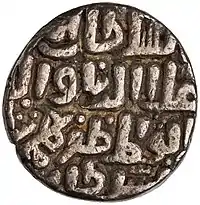Ala-ud-Din Bahman Shah
Ala-ud-Din Hasan Bahman Shah (Arabic: علاء الدين بهمن شاه; died 11 February 1358), whose original name was Zafar Khan, was the founder of the Bahmani sultanate.
| Ala-ud-Din Bahman Shah | |
|---|---|
| Sultan of the Bahmani Sultanate | |
| Reign | 3 August 1347 – 11 February 1358 |
| Successor | Mohammed Shah I |
| Born | Zafar Khan |
| Died | 11 February 1358 |
| Burial | |
His original name was Zafar Khan titled with "Alauddin Bahman Shah Sultan - Founder of the Bahmani Dynasty" with his capital at Gulbarga (Hasanabad) and all his coins were minted at Hasanabad.
Ancestry and early life

Zafar Khan was a noble in the employ of Muhammad bin Tughluq. His descent is unknown.[1][2] However, there is a popular legend regarding him narrated by the 17th century poet Ferishta, which says that he was a servant of a Brahmin astrologer named Gangu (Gangadhar Shastri Wabale) of Delhi and he was himself called Hasan Gangu. Historians have not found any corroboration for the legend.[3][4][5]
Zafar Khan began his career as a general serving under the Sultan Muhammad bin Tughluq. He was made a governor. In 1347 he was made commander of an army in Daulatabad. On 3 August 1347 Nasir-ud-Din Ismail Shah (Ismail Mukh, whom the rebel amirs of the Deccan placed on the throne of Daulatabad in 1345) abdicated in his favour and he set up the Bahmani Kingdom with its headquarters at Hasanabad (Gulbarga).[6][7]
Before the establishment of his kingdom, he was holding the jahangir of Miraj, Belgaum and Hukeri on behalf of Tughlaq's and he used to live along with his widowed mother at Miraj town. After establishing his kingdom, he handed over his kingdom to his eldest son. The sources like Isami and The Buran mentions Miraj was his headquarters of his Jahangir. [8]
Reign
On establishing an independent kingdom Zafar Khan took the title of Abu'l-Muzaffar Ala-ud-din Bahman Shah.[7][5] He gave Ismail Mukh a jagir near Jamkhandi and later conferred to him the highest title of his kingdom, Amir-ul-Umara. But Narayana, a local Hindu chieftain still succeeded in turning Ismail against Bahman Shah for a short period before he poisoned Ismail.[9]
Bahman Shah led his first campaign against Warangal in 1350 and forced its ruler Kapaya Nayaka to cede to him the fortress of Kaulas. His kingdom was divided into four provinces and he appointed a governor for each province.[9] During his reign Hasan fought many wars with Vijayanagara. By the time of his death the kingdom stretched from north to south from the Wainganga River to Krishna and east to west from Bhongir to Daulatabad.[10]
He was succeeded by his son Mohammed Shah I after his death in 1358.[10]
References
- Avari 2013, p. 88.
- Kulke & Rothermund 2004, p. 170.
- Chandra 2004, p. 177.
- Majumdar 1967, p. 248.
- Bhattacharya 1972, p. 100.
- Mahajan, V.D. (1991). History of Medieval India, Part I, New Delhi:S. Chand, ISBN 81-219-0364-5, pp.279-80
- Bhattacharya. Indian History. p. 928
- Congress, Indian History (2007). "Proceedings, Indian History Congress". Retrieved 4 June 2019.
- Majumdar 1967, pp. 249-250.
- Bhattacharya. Indian History. p. 929
Sources
- Avari, Burjor (2013), Islamic Civilization in South Asia: A history of Muslim power and presence in the Indian subcontinent, Routledge, ISBN 978-0-415-58061-8
- Bhattacharya, Sachchidananada (1972), A Dictionary of Indian History, Westport: Greenwood Press
- Chandra, Satish (2004), Medieval India: From Sultanat to the Mughals-Delhi Sultanat (1206-1526) - Part One, Har-Anand Publications, ISBN 978-81-241-1064-5
- Kulke, Hermann; Rothermund, Dietmar (2004), A History of India (Fourth ed.), Routledge, ISBN 9780415329194
- Majumdar, Ramesh Chandra (1967), The Delhi Sultanate, Bharatiya Vidya Bhavan